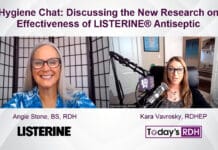Practicing clinicians must understand the differences in the types of dental research and clinical relevance when reading and reviewing scientific literature. This awareness helps ensure dental professionals provide the best possible care to patients and can assist in determining the best recommendations or tools to improve their oral health.
Placing too much weight on a study that may not carry significant clinical relevance may not provide patients with the treatment or product recommendation needed to control dental disease. This can leave both the patient and the clinician frustrated. On the other hand, purposely ignoring research that could improve patients’ oral health because of a personal bias could be considered neglect.
Both situations are not desirable and should be avoided. The best way to avoid such situations is to let the science lead us to the answer while leaving our own personal biases out of the equation.
In Vitro Studies
In vitro is Latin for “within the glass,” describing studies done in test tubes, usually in cell cultures. The type of cell culture used varies and should be taken into consideration when interpreting results.
For example, if you were studying a respiratory virus, you wouldn’t want to use kidney cells. The more appropriate cell culture would be lung cells. This is an example of an event that occurred at the beginning of the COVID-19 pandemic when a study was done to determine the efficacy of hydroxychloroquine as an effective treatment. The study used kidney cells, which showed promise. However, the results differed when the same study was conducted using lung cells.1
In vitro studies are very important, but we must be careful not to extrapolate the findings to mean the same will occur in a living organism. A relevant example in dentistry is chlorhexidine. I personally do not like the stuff because the stain it causes on teeth is a nightmare to remove.
However, I see hygienists citing that the reason not to use chlorhexidine is because it “inhibits fibroblasts.” Though I do believe we have alternatives that we can use in place of chlorhexidine that are very effective, the only studies showing fibroblast inhibition are in vitro studies. Therefore, we can’t say with great certainty that this occurs in a living organism. Taking it off the table as an option doesn’t benefit our patients, especially if they do not respond well to other products that replace chlorhexidine.
There are multiple advantages to in vitro studies. In vitro studies are often the beginning of the process of determining the clinical relevance and safety of products used in humans. A few of the advantages of in vitro studies include controls of physical and chemical environment, lower cost, higher throughput, and reduced animal use.2
In Vivo Studies
In vivo is Latin for “within the living.” This type of study is conducted in a living organism: an animal, a human, or, in some cases, plants. Animal studies are helpful but should not be extrapolated to humans. Rather, they are another steppingstone to determine safety and efficacy before moving forward in human trials.
Some studies stop at animal trials because of safety or efficacy concerns. However, this can be misleading. For example, when aspirin was discovered, there were little to no regulations on clinical trials and studies. If there had been, though, aspirin would have never made it to market since it kills animals (such as cats and rats) at a very high rate.3 Yet, we know it is relatively safe in humans and provides some level of therapeutic effects.
In vivo studies are the studies we should be relying on when determining how effective a certain medicament is in preventing or slowing the progression of a disease and what factors play a role in disease onset and progression. The environment is less controlled, and other factors come into play. Placing a sealant on an extracted tooth versus placing one on a tooth in the mouth is a much different experience as you have saliva, a tongue, and cheeks to control, not to mention patient comfort.
One might determine sealants to be a very simple task if we extrapolate the experience from the extracted tooth exercise. However, as practicing clinicians, we know the task can be more demanding, with more variables, and require extra supplies (i.e., suction, cotton rolls) that aren’t required in a more controlled environment, such as a single extracted tooth.
Risks of the Misuse and Misinterpretation of Study Results
The Federal Trade Commission and the Department of Justice acted against a company claiming their xylitol nasal spray prevented and treated COVID-19 infections. Many hygienists who are champions of the company were upset over this action. However, this is an example of misrepresenting study results.4
The studies cited in their claim were in vitro, meaning they were in a controlled environment, and no living organism was used to determine the efficacy, making these claims unsubstantiated. As you can imagine, these claims could provide a false sense of security for those using the product. Unfortunately, this could and did lead to COVID-19 infections in people who thought they were protecting themselves.4
This isn’t a new trend, as misinformation used to sell products or instill doubt has been going on since the beginning of time. The misuse of study results by exaggerating, reconfiguring, or misinterpretation has been an obstacle for the scientific community since the beginning of time.
Fluoridation of water has been an ongoing battle since its benefits were first discovered. Tons of studies, both in vitro and in vivo, have been done to determine toxicity and other developmental concerns (IQ level, developmental neurotoxicity, reproductive toxicity). The in vivo studies clearly show fluoride is safe and effective. However, countless people still refer to the in vitro studies as proof fluoride is harmful.5
This type of misuse of study results has caused heated debates and, in some cases, such as Calgary, Alberta, resulted in the discontinuation of water fluoridation in 2011. However, cost and ethical concerns were cited as additional reasons to end water fluoridation.
Interestingly, this pause in water fluoridation provided an opportunity to evaluate the benefits versus risks and costs of water fluoridation on the population, and the results were in line with past in vivo studies. The cessation of water fluoridation posed a risk to the oral health of children, which could have been largely avoided by understanding the significance of in vivo study results versus that of an in vitro study, as well as the following guidance from experts.6 Water fluoridation was voted to be continued in Calgary due to the findings presented during the time period of the water fluoridation cessation.
Further, this type of misinformation through misinterpretation of study results has fueled the infodemic and caused harm to people and animals through easy access to health information. Ease of access to health information either via “health influencers” or simple online searches of scientific literature is a concern.
A recent study published in the Annual Review of Public Health found the quality of health information easily accessible online was poor: 96% of participants used an unaccredited source for information. Unaccredited sources are more likely to provide false, reconfigured, or misinterpreted study results. Further, health literacy among US adults was low in at least 36% of the population. These individuals are more likely to delay or avoid treatment, have poorer overall health status, and have higher mortality rates.7
Lastly, the study evaluated if people were being harmed by online misinformation. They focused on online misinformation for the treatment of cancer. The authors found that educated younger females with a higher income were most likely to fall prey to “natural” treatments for cancer, ending in double the risk of death when compared to more conventional cancer treatments.7
The spread of misinformation via unaccredited online sources that misrepresent, exaggerate, or reconfigure study results is a threat to public health. In some cases, as highlighted by the results of the study showing educated women are at the highest risk of being prey to misinformation regarding cancer treatments, even education isn’t enough. Health literacy is different than simply being educated.
As health care professionals, we can help our patients, friends, and family improve their health literacy. This all starts with a better understanding of the science being represented in online claims.
In Closing
The importance of understanding the difference and clinical relevance of in vitro versus in vivo studies is a foundation to build on. Being mindful of the type of study and the medium or organism used to determine safety, efficacy, or causality is a duty of health care providers. This has never been more important than it is now, with so much information at the fingertips of our patients. Reading and interpreting scientific studies is often confusing and daunting to individuals who are not experts in the field of study they are attempting to understand.
As science majors and experts in the field of dental hygiene, we should take the time to understand how to determine relevant studies from those that are irrelevant. With this knowledge, we can guide and help our patients better understand the safety and efficacy of the products we use and, in some cases, the adjunct therapies we recommend.
Before you leave, check out the Today’s RDH self-study CE courses. All courses are peer-reviewed and non-sponsored to focus solely on high-quality education. Click here now.
Listen to the Today’s RDH Dental Hygiene Podcast Below:
References
- Hoffmann, M., Mösbauer, K., Hofmann-Winkler, H., et al. Chloroquine Does Not Inhibit Infection of Human Lung Cells With SARS-CoV-2. Nature. 2020; 585(7826): 588-590. https://www.nature.com/articles/s41586-020-2575-3
- Graudejus, O., Ponce Wong, R.D., Varghese, N., et al. (2019). Bridging the Gap Between In Vivo and In Vitro Research: Reproducing In Vitro the Mechanical and Electrical Environment of Cells In Vivo. Conference Abstract: MEA Meeting 2018 | 11th International Meeting on Substrate Integrated Microelectrode Arrays. https://www.frontiersin.org/10.3389%2Fconf.fncel.2018.38.00069/event_abstract
- Bell, J. Aspirin Killed the Cat: Animal Research Models Do Not Always Apply to Humans. Expert Opin Drug Metab Toxicol. 2019; 15(9): 683-685. https://pubmed.ncbi.nlm.nih.gov/31382791/
- United States of America v. Xlear, Inc. (2021, October 27). Federal Trade Commission. https://www.ftc.gov/enforcement/cases-proceedings/2123045/xlear-inc
- Guth, S., Hüser, S., Roth, A., et al. Toxicity of Fluoride: Critical Evaluation of Evidence for Human Developmental Neurotoxicity in Epidemiological Studies, Animal Experiments and In Vitro Analyses. Arch Toxicol. 2020; 94(5): 1375-1415. https://link.springer.com/article/10.1007/s00204-020-02725-2
- McLaren, L., Patterson, S.K., Faris, P., et al. Fluoridation Cessation and Children’s Dental Caries: A 7-Year Follow-Up Evaluation of Grade 2 Schoolchildren in Calgary and Edmonton, Canada. Community Dent Oral Epidemiol. 2022; 50(5): 391-403. https://onlinelibrary.wiley.com/doi/10.1111/cdoe.12685
- Swire-Thompson, B., Lazer, D. Public Health and Online Misinformation: Challenges and Recommendations. Annu Rev Public Health. 2020; 41: 433-451. https://www.annualreviews.org/doi/10.1146/annurev-publhealth-040119-094127











